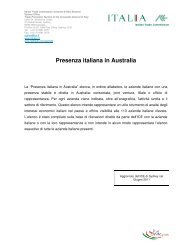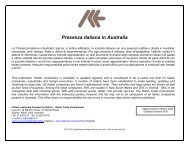Price Determination in the Australian Food Industry A Report
Price Determination in the Australian Food Industry A Report
Price Determination in the Australian Food Industry A Report
You also want an ePaper? Increase the reach of your titles
YUMPU automatically turns print PDFs into web optimized ePapers that Google loves.
Bottled oils are also see<strong>in</strong>g growth. Olive oil accounts for most of this, grow<strong>in</strong>g by around 10 per<br />
cent per annum and represent<strong>in</strong>g 37 per cent of <strong>the</strong> total market. Non-olive oil use is decl<strong>in</strong><strong>in</strong>g by<br />
4.5 per cent per annum. Private label product accounts for around 50 per cent of total sales.<br />
The premium-priced segment is mostly canola (but would also <strong>in</strong>clude sunflower and specialty<br />
oils) and trades at a significant premium to <strong>the</strong> blended vegetable oil category. Monola (lowl<strong>in</strong>olenic<br />
canola) has done well but is heavily supported with market<strong>in</strong>g. Olive oil cont<strong>in</strong>ues to<br />
<strong>in</strong>crease, primarily driven by a strong market<strong>in</strong>g image. Canola oil dom<strong>in</strong>ates this category<br />
account<strong>in</strong>g for 26 per cent of <strong>the</strong> total segment by volume and is a major <strong>in</strong>gredient <strong>in</strong> <strong>the</strong> blended<br />
vegetable oils category, which accounts for 29.6 per cent by volume.<br />
The shares of all categories are shown below. However, as a s<strong>in</strong>gle oil category, olive oil has grown<br />
significantly to now hold 30 per cent of <strong>the</strong> segment by volume and almost half by value.<br />
Figure 88. Market mix of cook<strong>in</strong>g oils, 2002<br />
speciality<br />
4%<br />
sunflower 7%<br />
spray oil 2%<br />
olive<br />
30%<br />
canola<br />
26%<br />
blended vegetable<br />
31%<br />
Source: <strong>Australian</strong> Oilseeds Federation<br />
In terms of trends <strong>in</strong> <strong>in</strong>dividual oil types, <strong>the</strong>re has been:<br />
• a significant <strong>in</strong>crease <strong>in</strong> canola oil consumption (up from 14 per cent <strong>in</strong> 1987 to almost 60 per<br />
cent today);<br />
• growth <strong>in</strong> specialty oils such as peanut and sesame oil;<br />
• substantial growth <strong>in</strong> olive oil consumption with extra virg<strong>in</strong> and extra light olive oils driv<strong>in</strong>g<br />
growth; and<br />
• a decl<strong>in</strong>e <strong>in</strong> soybean oil consumption l<strong>in</strong>ked with trans fatty acid and genetic modification issues.<br />
COOKING OIL AND MARGARINE – ANALYSIS OF PRICING<br />
Retail pric<strong>in</strong>g<br />
Represented below is our analysis of <strong>the</strong> share of <strong>the</strong> current returns for each major sector<br />
engaged <strong>in</strong> <strong>the</strong> oils and fats value cha<strong>in</strong> as it relates to bottled cook<strong>in</strong>g oil (note that <strong>the</strong> farmgate<br />
to wholesale component <strong>in</strong>cludes both primary and secondary process<strong>in</strong>g).<br />
Figure 89. Share of retail price of cook<strong>in</strong>g oil, 750ml bottle<br />
%<br />
100<br />
80<br />
60<br />
40<br />
20<br />
0<br />
Source: <strong>Industry</strong> sources<br />
retail<br />
wholesale/marketer<br />
primary processor<br />
farmgate<br />
<strong>Price</strong> <strong>Determ<strong>in</strong>ation</strong> <strong>in</strong> <strong>the</strong> <strong>Australian</strong> <strong>Food</strong> <strong>Industry</strong> A <strong>Report</strong><br />
83







